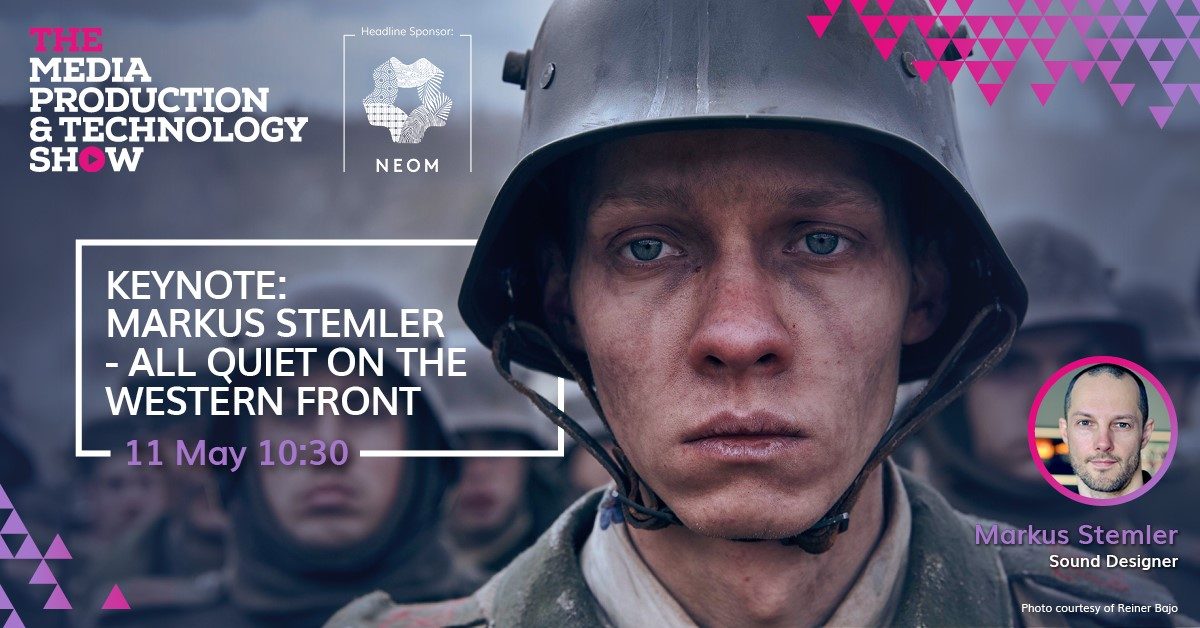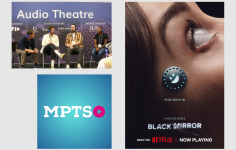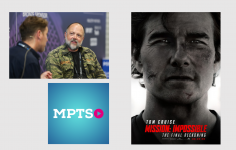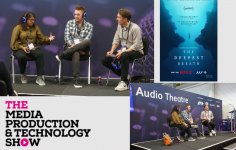At the recent Media Production and Technology Show 2023, Resurface co-founder Ben Nemes spoke one-to-one with Markus Stemler in front of a standing-room-only audience at the Audio Theatre. Markus spoke about his craft, his career, and his award winning work on the sound of All Quiet on the Western Front.
The full recording of that interview can be found here:
A full transcript is below.
Ben Nemes: Good morning everyone, and welcome to day two of the Media Production and Technology Show 2023. You join us at the Audio Theatre for the first session of the day. It’s our keynote chat. My name’s Ben Nemes, I’ll be your host. And I’m delighted to tell you that I’m joined by Markus Stemler, who’s come from Berlin last night to be with us. We’re going to talk a little about Markus’s craft, Markus’s career, and then we’ll dive a little bit into a very particular piece of work that I’m guessing many or all of you will certainly know about, probably have seen. And if you have seen, certainly have enjoyed – called All Quiet on the Western Front. A feature film that I believe was shot in 50-something days? It was quite a quick shoot.
Markus Stemler: I think it was 60 days of shooting, something like that.
BN: Over here, you’d see that on Netflix. All Quiet on the Western Front was nominated for an American Academy Award – an Oscar, for sound. The more important award, the BAFTA, the British Academy Award, it of course won! So congratulations on that – well deserved. You got the AMPS Award as well, is that right? AMPS is the Association of Motion Picture Sound, if you’d like to see them, Andrew’s on the stand. They’re about 20 yards in that direction.
So, without further ado, we’ll get started. We should be about 40 minutes, give or take.
Questions: a couple of cabin announcements. First of all thanks to Alex who’s doing our sound today. You should all be on the blue channel. You’ll be very confused if you’re not.
If you want to submit any questions as we go along, there’s a thing called Slido (slido.com). If you use the hashtag MPTS2023, that will allow you, as questions come to you, to submit questions. Towards the end, I’ll check my phone for any questions that you have for Markus, and we can look at those at the time. If, during the questions, you are struck by the need to ask an urgent one, there is a radio mic somewhere. We can accommodate those too if you can’t get onto the slido at that point.
I think that’s everything.
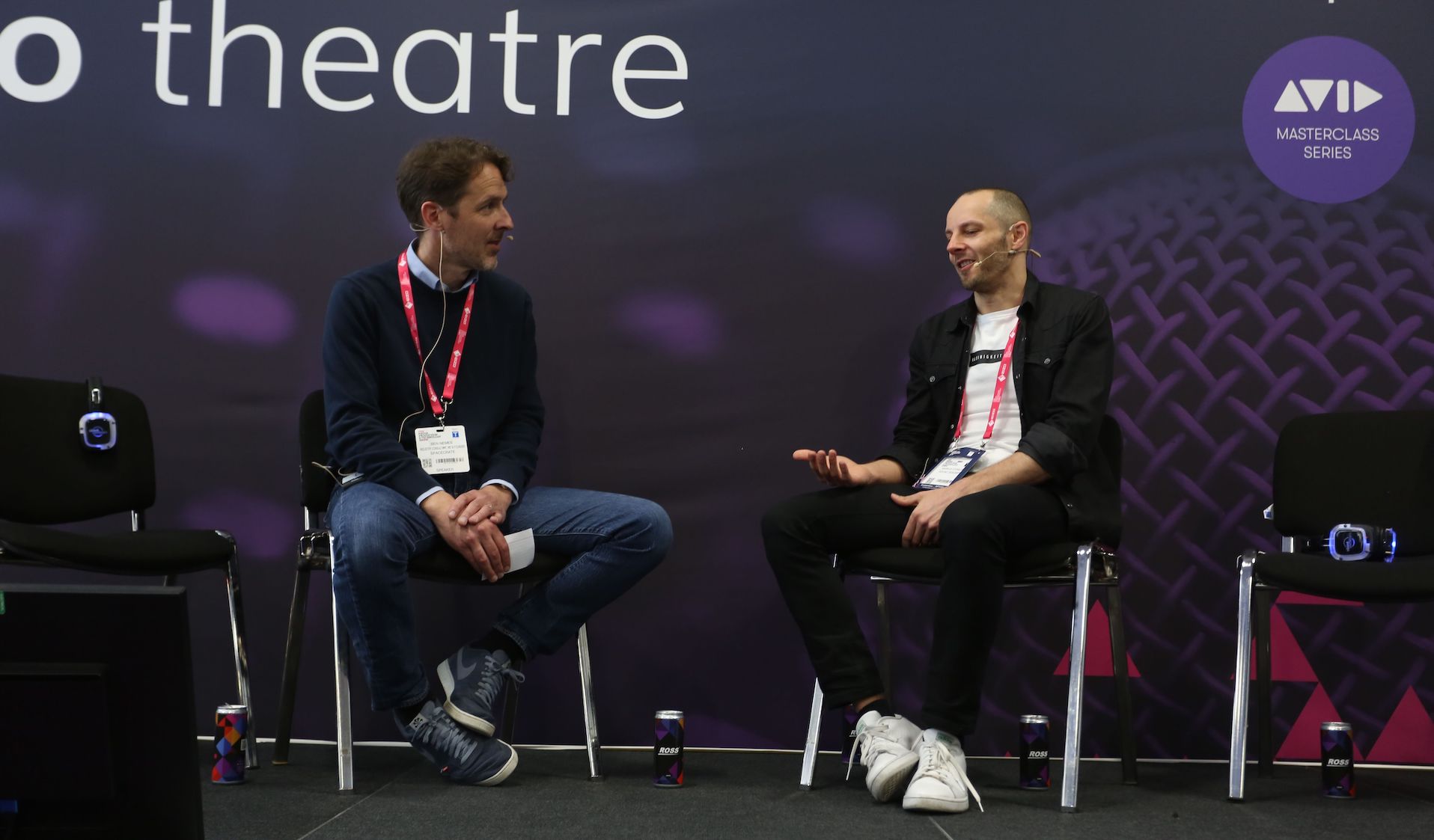
So, Markus, we’ll get into the specifics of All Quiet on the Western Front, but I think we’re going to make our way there. What always fascinates me is the journey to becoming a supervising sound editor. Just because it’s not something that, at school or at college, you see as ‘a thing’. It’s not architect / firefighter / supervising sound editor. And so I’m always curious, there’s always a moment, there’s always an epiphany or some sort of awakening of this is what I want to do. And the route there I think is always interesting. So what’s your origin story?
MS: Good morning everybody. My story? I knew that I wanted to do something with sound pretty early on, but I hadn’t heard about something like sound editing. I didn’t have a clue that people do that. I was really interested in music production and, as a normal thing as a teenager, maybe you go to music school, you learn to play an instrument. I learned to play the piano a little bit and then you end up playing in bands or whatever. And for me, that never really happened. I never ended up playing in a band somehow, back at that time, in my area, having a keyboard on stage was really the last thing any band would be looking for.
BN: This is the 90s, when no-one wanted keyboard players?
MS: Exactly. So it was all about punk rock and grunge and all about guitars, really. So I never ended up playing in a band, but maybe that was a good thing because that somehow led me to “Well, maybe I can start recording these bands?”. And that’s what I started to do. With my dad, I build a little home recording studio in the basement. And then I started to record bands in our house, basically, which was sometimes a little full-on for my parents actually! So I followed that path for quite a while. I also started working a little bit at the local theatre and someday one of the sound techs at the theatre recommended to check out the sound faculty of the film school in Babelsberg, which is close to Berlin, where the film studios are. And so I went there for, what do you call it? The open doors?
BN: The Open Day?
MS: Open day. Yeah. So I went there and checked it out. Back then, especially as a teenager, if you’d see a mixing desk that is five metres wide, it feels like this is the place where you want to spend time! And so I made a decision. I really wanted to go to that film school, and I applied, and luckily it worked out. But at that point I still didn’t have any clue about film sound, really. I had never been on a set, I didn’t know what to do with a boom pole. I was still interested in music production and at that film school they had a really cool thing for the students. They had a deal with the local film orchestra. So every six or eight weeks there was a recording session. Only for the students. The orchestra would come in and they would play the little scores and pieces that the students had written.
BN: Oh, wow.
MS: Amazing. That’s fabulous if you haven’t done that before, I’d never had such an experience. I did that a couple of times. I wrote some little pieces of music for short firms and stuff like that. And then the orchestra came in and 30 people would play your stuff and this was absolutely overwhelming.
BN: It never sounded like you thought it was going to!
MS: No, no. Absolutely overwhelming. I mean, if you think about it, you start to work in film and normally all the early projects you do, they’re all a bit lousy and a bit crappy, but who cares if you can get a whole orchestra coming in? Play a score for you!
BN: So I guess by now you’re starting to narrow it down. You’ve gone from ‘something to do with sound’ and, as a keyboard player, I suppose there’s a technology aspect to that, that there probably isn’t for a drummer or a bass player. Computers get involved really quickly if you’re into keyboards and stuff, and then you’re narrowing it down to Film. At this point you’re enrolled in the film school and starting to have this amazing experience of recording actual orchestras, which so few will ever get to do anyway.
MS: The process was ended at some point, I realized that composing wasn’t really something that would work for me long term, because it just took me too much time. But naturally at the Film School, you’re exposed to all the different fields of film sound. So you do production sound, sound mixing, you have to do the editing, and later on you also do the mixing.
BN: So the course gives you that exposure to all the different stages?
MS: Yes. You go through all the stages together and you get an idea of how to produce film sound. And for me, production sound was never really something that I would develop a love for. It’s just that the challenge is something that, I don’t know, it’s not really my thing..
BN: It’s too cold!
MS: It’s too cold, and you have to make a lot of compromises also. I have the highest respect for all the people that can manage to do that. I’m just not the right person for working on a set. And ending up in the re-recording stage was also not my thing, because you’re sitting in a dark room all day long. But then I also felt like sound editing, it felt to me like a very boring thing to do! You know, back then it was very common, also because of the level of technology, that what you could do during sound editing was a bit limited. So, you would basically collect sounds cut them in sync to picture, and that was mainly it. And then you would go to the rerecording stage and that was where all the fun stuff happened.
You would start levelling things. You would use reverbs, you would use EQ and really form a soundscape, but that normally didn’t happen during the sound editing. Which is why it didn’t really feel appealing to me. If you compare it to the kitchen, if you’re cooking: For me, sound editing was a bit like – you’re the guy that goes to the supermarket, gets the ingredients, peels it, cuts it, cleans it, and then you put it on the table and then the chef comes in and then they will start cooking. And so, at some point, I didn’t really know what to do, really.
And then and then a project came around the corner that was really a game changer for me. It was a student film, but it was sound supervised by a guy who had already finished film school.
He guided us how to do it on this film. And he also showed us his way of working. So he had a little bit of a different style of working. He would just ignore all that I mentioned earlier, the common rules that, as an editor, you don’t really do much of what I call the fun stuff. He would just collect the sounds, treat them, mess around with them, level them, pan them, and do all sorts of things. Like basically doing the editing and do already a premixing pass. This guy’s name is Frank Kruse.
BN: Right, OK. So this is the moment. Behind everyone’s story there’s a moment. You having someone show you something that changed your mind, and opened your mind, and for that person to be Frank. In that sliding doors thing, that’s the sliding doors thing, isn’t it? That’s the moment.
MS: Absolutely. Because as I mentioned, until then, I felt like sound editing is really kind of a boring part of the process. But seeing how he worked really changed everything for me, because it’s not just about doing all the fun stuff. The more important part is that you want to present an idea to the director. So if you create a soundscape, it’s hard to present the full version of your idea, of the idea you have in mind. If you don’t do a little bit of premixing and creating a soundscape that doesn’t need any computing in your head. Like, if you have to tell the director, “OK if you imagine these elements come from the left and these come from the right and these are a bit further away, this is my idea. What do you think?”
And it doesn’t really work unless someone has a lot of experience and imagination. Now it’s a bit like coming back to the kitchen.
You invite a director to your edit room, then you try to present your idea, and you point them to the chopping board where you have slices of onions and some chopped potatoes and a bag of un-boiled lentils. And then you say, okay, this is my vision. How do you like it so far? And it doesn’t really work. The director likes to taste the soup.
And so by doing that, by really cooking and boiling during the editing process you were able to present the whole idea you had in mind. And that really changed everything for me. Then suddenly I thought, OK – this is interesting.
BN: It sounds like the big moment because, for those that don’t know, Frank we’re talking about now, Frank Kruse, was the co-supervising sound editor on All Quiet on the Western Front. But that’s the culmination of quite a lot of work you guys have done together, starting at film school, when an already-graduated supervising sound editor came in and showed you the way.
How did you guys move from there? I guess you’ve worked together a lot, I know a couple of things. I first came across Frank’s work on Rush, the Ron Howard thing. Sorry, I’m answering for you!
MS: So what happened after that, the student project, the first thing I did was that I did an internship at their place. And by that time they were working on a film, it’s called Perfume: Story of a Murderer, which was quite a big German production. The normal stuff you do when you do an internship.
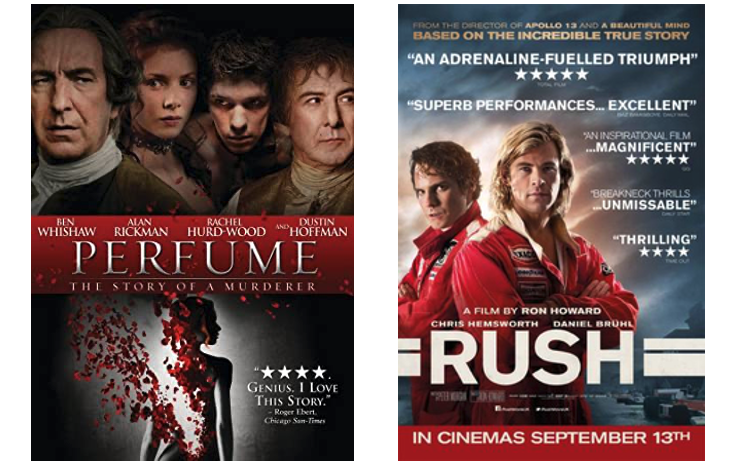
You clean up the foley stage, you paint walls. I ended up cutting some footsteps of people walking by in the background. So that was everything I did. Then the internship ended, but I just didn’t leave, and nobody threw me out. So I just stayed there and this is where I started to work with Frank a lot.
This is maybe 15 years ago or something. Then, with every project we worked together, I learned a lot from him in working with him. And today we are sound design partners and the way we work is really like we split the project.
BN: It’s quite tricky though, having two people as supervising sound editors? Because you need to really know where you stop and they start. And you need to know that when you take that thing apart into two places, that it comes back together again. And works. Is that just a thing you know, now it’s been so many years, or is there a set formula? Do you have rules of: you don’t touch that, I won’t touch this?
MS: Well, this is what you do, at the beginning, it’s quite a common thing to split work into what we call food groups. Somebody would do the backgrounds or just the car-bys or things like that. That’s what we did at the beginning and nowadays it’s more like we split the film into sections: Somebody’s doing the first half, somebody’s doing the second half maybe.
And the way, or why, this works is because over time we really aligned ourselves. Our ideas and our vision in terms of aesthetics is pretty much in line. So when we put these sections together, it’s not like at the joint you will hear a shift or something. And that’s something that really developed over time and we pretty much know what the other one is doing. Sometimes the timeframe is really short and sometimes we don’t get to listen to what the other one actually did on the film. You just have to know.
We worked on a film a couple of years ago where he was doing the first half, I was doing the second half and I never got to listen to it. And we sent it off because also we couldn’t take part at the mixing. But it all worked out.
BN: I want to get into the meat of All Quiet a bit as well. So you guys worked on a few films over the last 15 years, after that initial meeting, and working on the student film, and then with working under Ron Howard on Rush, that was what, 20…..?
MS: 2013 I think. It was a very big thing for us.
BN: Was that a big step up for you guys, into Rush?
MS: Definitely, definitely. Actually we couldn’t believe that this is happening in Germany, but it happened because there was some funding, so they had to do the sound work in Germany.
All of a sudden it was Ron Howard coming in and we’re working on a Formula One movie with him. Obviously on a film like that sound is so important.
BN: We’ve seen that a lot with Drive to Survive and what Nick Fry and his team are doing on that. It’s a lot of fun. They’ve got a lot to work with and they seem to really enjoy it. I imagine you had the same kind of experience. The subject matter lends itself to, ’Right, we can do some stuff with it’.
MS: It’s a movie you wish for to happen. But it’s also a lot of responsibility, really. Working with Ron and especially also his editor, Dan Hanley was, I have to say, the best experience. Sometimes I think if directors have proven that they can do excellent work, they don’t need to show it? So the vibe was really relaxed. I can say that all of these guys, they were total team players. It’s not like they kind of command you. So they, and I think it’s always the case with good directors, they try to get your creative input and that’s what happened on Rush. It’s also what happened on All Quiet on the Western Front.
The Sound of All Quiet on the Western Front
BN: Let’s do that now. Show of hands – who has seen All Quiet on the Western Front?
MS: Oh wow!
BN: ‘Cos Netflix won’t tell you who’s seen it. Right? There’s no way of knowing! It’s a staggering piece of work. My congratulations on that. And it’s also – in the nicest possible way – horrible. As in, it’s unsettling. It’s not an easy watch. It makes you really, really uncomfortable. And most of that’s your fault, I think!!
When you’re thinking about a World War 1 piece, what you don’t have as a starting block, is library. You don’t have sound effects. When you’re doing a thing set in Manhattan in 1986, you’ve got a bunch of stuff you can get to, to define that Manhattan in 1986 sound. There’s nothing, I guess, with World War 1? Also, I suppose the timing of the shoot was such that you couldn’t really go to set and record tanks and artillery and the hardware that’s so evocative. So where do you start with building that soundscape of the battlefields of World War 1?
MS: So basically it all starts with the script, of course. We got to read the script before they started shooting, and you read into it and immediately you notice, OK – this is this is a huge challenge.
Obviously with all the battle sequences and stuff, what you normally do as a sound designer, you go through the script and you look for sonic treasures that you could find at the set.
And with this film, they had built this huge battlefield, it was shot close to Prague and they really built an outdoor battlefield. They were exposed to all the weather. They shot in March, I think. So they had rain, they had snow and so it was muddy, it was cold…
BN: If they’d shot in the summer when it’s dusty and dry. It wouldn’t work, right?
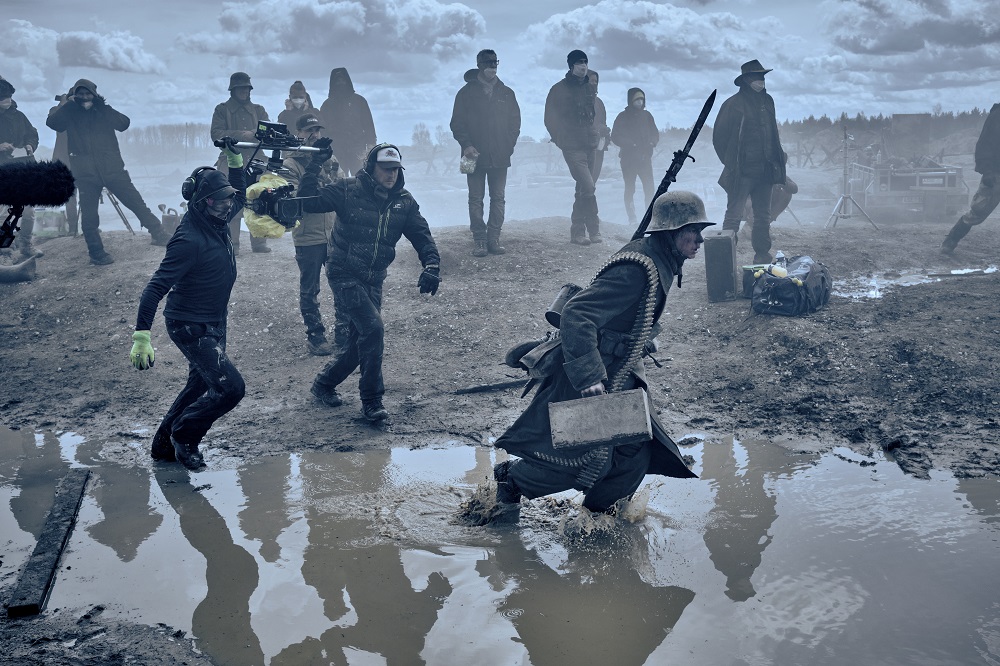
MS: …It wouldn’t really work. Right. So when you think of reading through the script, you have all the historic vehicles that are very interesting to capture, but then you also have tons of extras running through the mud, falling into the mud, screaming. We have prop explosions, gunshots. You really want to capture that. And normally what we would do, Frank and me, we would go to the set and do the recordings apart from the actual shooting. But it was a high time of Covid, so we weren’t allowed to go there. So Frank basically got in touch with the production sound mixer – his name is Viktor Prasil, a Czech guy, to discuss how we could capture these sounds. And luckily Viktor is the most amazing guy. He was really looking forward to capture all that, he had already made lists on his own of what to do in terms of wild tracks and stuff.
BN: He could have been a different kind of person “I’m busy enough! It’s muddy, it’s horrible, I’ve got mics, I’ve got radios…”
MS: If you have if you have a shooting day that lasts, like 10, 11 hours and in these kind of conditions.
People are literally losing their shoes every day in the mud, and there were people that had to be dragged out with the crane because they were sunk in mud, down to the hips! If you, after such a day of shooting, raise your hand as a production sound mixer and go like, OK – let’s, let’s do a bunch of wild tracks with 50 extras…
BN: Everyone really wants to go home.
MS: You know, can you throw yourself in the mud again?
BN: Just one more time!
MS: You really don’t get a lot of smiles. But luckily – and that was a very important thing on that film – Edward Berger, the director, he was really looking to capture all these sounds. He was on the same page with us, basically. So he said, OK, we’re gonna do these wild tracks. And he really created that vibe on set that everybody thought, yeah, okay, this is important stuff and we need to do it. So we got a lot of wild tracks from set and that became our foundation to work with.
BN: And it’s detailed as well. There’s a battle scene where the battle shifts. It’s to-and-fro between French and German and, it’s quite subtle, but the sound of the battle changes. I’m not sure which order it goes in, but as the French get the upper hand or the Germans get the upper hand, the horrendous cacophony of war changes a bit. That’s you reflecting that in sound. And how do you do that? It sounds, weirdly more French, when the French are doing better, kind of thing?
MS: There’s one very interesting aspect about the way this film is filmed in terms of camera, because they only use one camera.
There’s not a lot of multi-angle coverage and the camera pretty much stays on the protagonist Paul Baumer for long stretches. So a lot of what’s happening on the battlefield is actually told through sound, off screen. So we had to create the envelope of the battle in the sound.
It starts with ‘when do the French start firing and when do they not?’. ‘Which gunshots sound more dominant at every single moment of the battle?’ because, as you said, we need to address the aspect of who’s having the upper hand in every moment.
BN: Because the camera’s not showing it. And even if it was, it’s so chaotic, you’ve got no way of knowing. So the only way you know how it’s going, is this kind of dominance of one or other. It’s partly dialogue. It’s partly crowd, it’s partly machinery…
MS: It’s hundreds of elements in the sound, as you said I’ve got all the screaming, the gunshots, the body falls, the fly-bys…And you really play with these elements in a very dynamic way. So you have to think about when to hear what. It’s very important because there are some moments during the battle where Paul is completely overwhelmed by the chaos that is going on. So in these kind of moments, you kind of go all-in and have a lot of elements flying around in the soundscape. But then there are also these elements where he gets overloaded by what’s going on. And then that’s where a drastic shift happens actually, and also sound wise, because as he can’t take in what’s going on around him, you shouldn’t hear it.
BN: There’s that scene towards the end, with him and the other soldier. Where it’s just so chaotic and there’s just murder everywhere. And he’s kind of [covers ears] and the perspective follows that
MS: Exactly
BN: There’s things he needs to hear, just to survive, and there’s things he can’t handle hearing anymore. So he’s just like [covers ears].. ‘enough’.
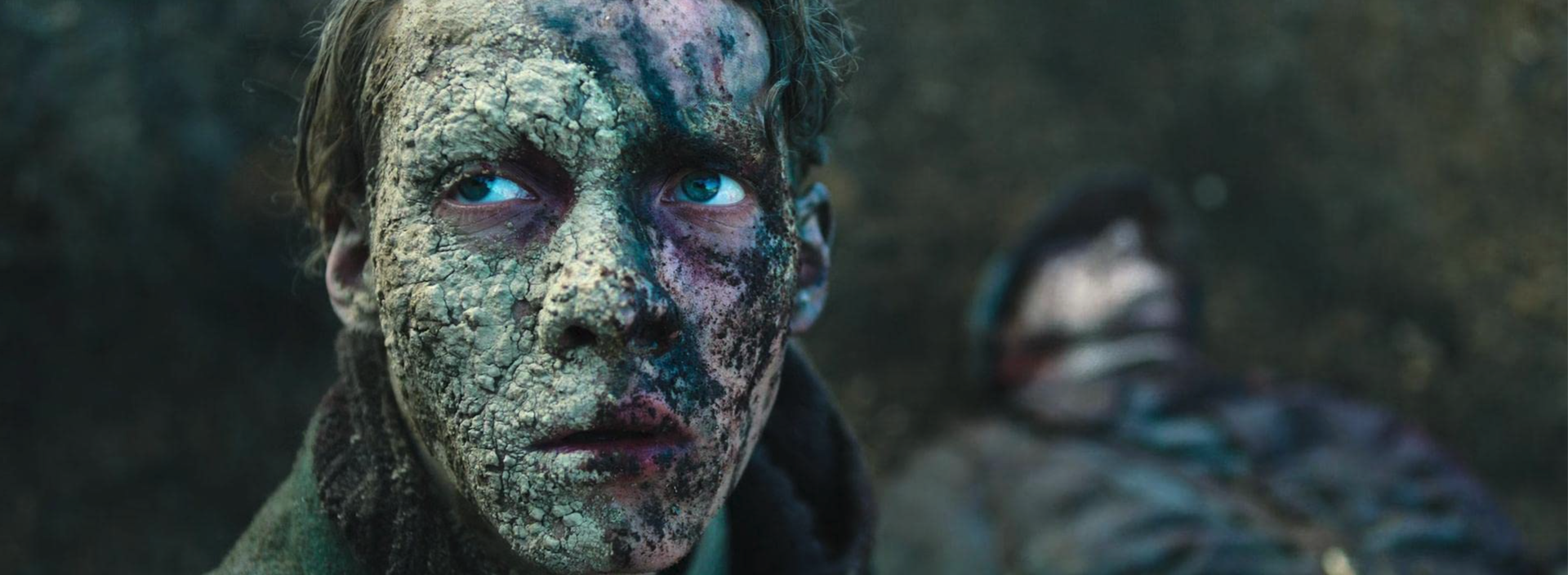
MS: It’s a very important aspect of that film, to imagine how things would sound through his ears. And to take the subjective angle of Paul Baumer, the protagonist, because it actually was one important thought we had when thinking about the whole approach of that film. These soldiers, they do their journey from being very enthusiastic when they’re still at home, when they look forward to going to war and doing glorious things. And then once they end up at the battlefield, they get to see the true face of war, and they get traumatised and then devastated in no time.
We really had to mirror that emotional journey into the sound, and think about how everything they hear, what impact does it have on them?
BN: Everything is Paul’s story. And the sound is exactly that. It’s not what’s happening on the screen in a literal way, on-the-nose. It’s ‘where is Paul at this point, psychologically’?
MS: And that was actually, when you first read the script and you think about, okay – this is a period film and you want to be authentic with the sounds that you use and the sounds that you create. But actually what does authenticity mean? Because we started to do some research, obviously, and then you find out that there’s hardly any sonic reference.
BN: Are you going to mention the letters. I’ve heard about these letters…
MS: Exactly right..
BN: …This is fascinating…
MS: You start doing research and you’re looking for sounds from the time, but you hardly find anything because the sound technology wasn’t …
BN: No WAV files you can buy…
MS: Exactly. So what we came across was letters that soldiers had written to their loved ones at home, and they described what they were hearing when they were at the front line. And the traumatic effect that the sounds had on them. So I remember it wasn’t only the shell firing and all the explosions – they had even nicknames for different grenades – but it was also…
People were talking about the sound of rotting bodies that they would hear during the night when there was no fight going on. It was a tremendous impact that sounds had on these soldiers. So for us, thinking about authenticity, we got the idea that it was mainly about the impact that the sounds had on the soldiers, as opposed to whether this and that sound sounded exactly as it did.
BN: That’s incredible, I think.
It’s not about what does this sound like? It’s ‘how does that sound make you feel?’ That’s all anybody cares about in terms of creative intent in sound design, in a feature film.
And of course you’ve got these soldiers who are writing to family and they’re going to try really hard to explain, to people that aren’t there. They have to work really hard to try and get across this horror. To someone who’s never going to experience it, and would never have heard anything like it. So they’re going to be really descriptive and really emotive, and you’ve got all this material. It’s not about how loud is the gunshot. It’s how does that make you feel? What does that trigger in you every time you hear it? How does that change as the weather changes. I think that’s fascinating. You talk about authenticity. That is the authenticity.
MS: Exactly. And you have to go along with how the protagonist feels in every moment because that changes over time and therefore the soundscape has to change with them.
BN: I must check in and see…I haven’t checked for questions.
We have one, we’ve got a few minutes left.
I think we just answered Jeremy’s question in some ways, but Jeremy asks, “where do you find your sound effects that you use in your films? What would you say the split is between bank sounds and bespoke recorded foley, et cetera?” Maybe you could answer that question for a ‘typical’ film. Is that different as opposed to your approach on All Quiet on the Western front? Do you tend to use bank effects or stock effects? Or do you always try and get what you can in terms of getting out with a mic?
MS: Ideally you try to record as much as you can. But the reality is you don’t get to do that for every sound.
BN: Especially not with Covid!
MS: It makes it even harder. So there’s always a mix of stuff, libraries you can get and then stuff you record. These days people do terrific work in capturing sounds and offering them as libraries. It’s always a mix really, but it’s hard to say a percentage.
BN: Also, seems the best work comes out of not having it available to you. You’re talking about how you’re going back to these soldiers’ letters to find inspiration for what the sound should be. It’s almost like that whole story (and whether it’s true or not, I don’t know) about how Spielberg never had a working shark, because it kept getting waterlogged. So he had to find other ways to create tension, which takes you to the John Williams motif and all this sort of stuff. You have to use other things to create emotion in the absence of saying, ‘that is the sound you want’. And I think that’s a great example, your work in going back to those soldiers’ correspondence to find, OK, well – we don’t have it – so what does it need to be?
Are there any questions in the room? I know we’ve got a couple minutes left of Markus’s time, so is there anyone else? We have one! Alex, would you mind throwing a microphone up to the gentleman at the back
Audience Member: Hi Markus. At what stage in the process do you get access to the music score? And does that change how you do your sound edit?
BN: We didn’t even mention that! We didn’t even mention Volker’s score…
MS: Actually, on this film we pretty much started at the same time. I think Volker came in, the composer came in, a little later, but they already had some layout music in the film. Normally it always has an effect, but if you talk about sound and music there’s always the talk about debating who’s working in which range of frequencies or something like that. And for me it never really makes sense. I think music and sound really need to create their vision and a full draft of that vision and then you figure out how that stuff works together in the mixing stage. And there’s always a way to make it work.
On this film, actually it was very easy because everything fell into place really because the way Volker composed the score really didn’t interfere with what we did and vice-versa. But it’s not always the case and then you have to figure it out at the mixing stage. But luckily it worked out very well.
BN: I think we’ve sadly run out of time. I could do this all day, but we’ve run out of time. It remains only for me to wish you luck – Markus is heading back, this evening, for the German Film Awards tomorrow.
MS: Thank you
BN: And the smart money’s on you guys for that one, I’d say! Thank you, for All Quiet on the Western Front and thank you for being with us this morning. Ladies and Gentlemen: Markus Stemler.
The Media Production & Technology Show returns to Olympia, London, on the 15th and 16th May 2024.
